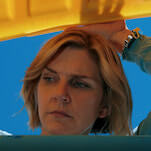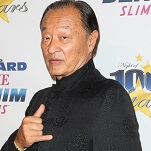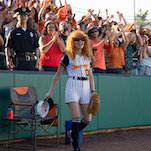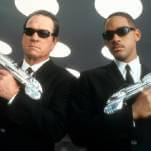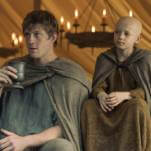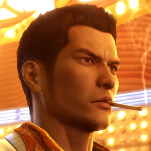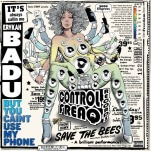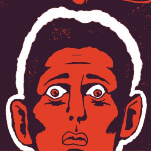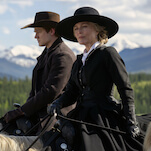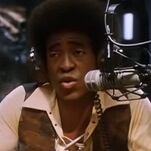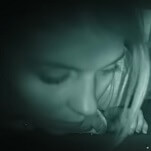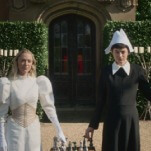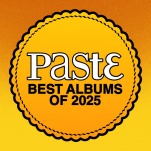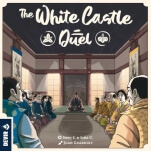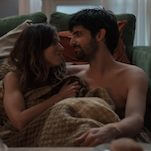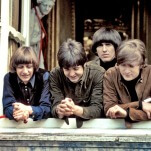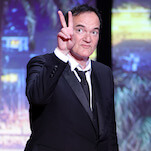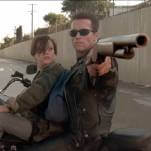The Dark Horse espresso bar on John Street is one of the go-to critics’ hangouts at TIFF, despite being a mostly uncomfortable place to write and work. There is only one table indoors—a pub-booth-style wooden rectangle, tucked away in a corner—and just a handful more on the unshaded, street-level patio, which is perpetually occupied by press-badged squatters and Euro distribution types who like to pretend that they don’t understand “no smoking” signs. Those who can’t snag a spot on either side of the windowsill have to make do with balancing their laptops and notes on the narrow wooden shelf that runs the length of the main wall.
A chalkboard sign out front proclaims Dark Horse “the unofficial coffee of TIFF.” Critics flock here for two reasons. First of all, the John Street Dark Horse has excellent Wi-Fi—the most precious commodity at TIFF. The festival provides free Wi-Fi at its main press and industry venue, the Scotiabank, but it is slow and spotty, and between screening rushes, the theater’s long glass lobby bar fills with laptops and netbooks, all locked in the same struggle to load Gmail. The second, equally important reason is that Dark Horse serves an espresso that is one of the few things that TIFF’s international attendees can agree upon.
On my last, drizzly day at the festival, I find myself in the John Street Dark Horse one final time, waiting in line for an Americano. The movie I’ve just gotten out of is The Look Of Silence, Joshua Oppenheimer’s follow-up to The Act Of Killing.
There’s a paradoxical quality to a critic’s experience of a festival like TIFF; major fests seem to occur in an abstracted, cosmopolitan non-space—where everyone is always checking their email, nobody knows how to get anywhere, and locals are met with looks traditionally reserved for new arrivals in spaghetti Western towns—and yet pride themselves on showcasing works with a political or social edge. After enough hazy days of back-to-back screenings, bad eats, and little sleep, the real, political outside world seems to fade away; only its image persists on-screen. TIFF is a little like an airport terminal—everybody walking around with backpacks, nervously checking schedules, rushing, going up and down escalators, paying too much for food they don’t like, occasionally going somewhere but mostly just waiting for some kind of departure. Or it’s like my home base for the past week, the Eaton Chelsea—“the largest hotel in Canada.”
In The Look Of Silence, Oppenheimer once again plays the part of a documentary genie, fulfilling wishes and filming the results. The movie takes on the structure of an elliptical arthouse thriller, following fortysomething optometrist Adi—whose blank, determined expression suggests at least a degree of rehearsal—as he meets various old men, usually under the guise of an eye exam, and asks them increasingly specific questions about their involvement in the mass purge killings that swept Indonesia in the mid-1960s. What the men don’t realize, but the viewer knows from early on, is that Adi is the younger brother of one of their victims, born two years after the killings and treated by his mother as a lookalike “replacement” for her first, murdered son. He is a kind of revenant.
Even more so than its predecessor, The Look Of Silence invites accusations of disingenuousness. Not only is Oppenheimer deliberately entrapping the interview subjects, all of whom previously admitted to participating in the murder in interviews conducted for The Act Of Killing, but he’s also fiddling with the footage, employing composited TV screens, transparently unrelated reaction shots, and dubbed-in questions to streamline the narrative.
I heard a fair amount of incredulous post-screening reactions from colleagues in line at the Dark Horse and on the sidewalks of Richmond and John streets, and though I think it’s fair to quibble with Oppenheimer’s practices, I don’t think that said quibbles add up to a cohesive, cogent position against the film—unless, of course, one presumes that the only function of documentary filmmaking is journalism. The Look Of Silence strikes me more as a work of participatory fiction, its semi-staged setups adding up to a portrait of a society that has never confronted its violent past, and is thus trapped in it. (At least one of the interviews ends with a very thinly veiled death threat.) In other words, Oppenheimer is aestheticizing a genocide, at least thematically speaking; this is what gives The Look Of Silence its queasy wallop, and what makes it so fascinatingly problematic. Though I like the film, I’m still mulling it over, and, for that reason, I’m withholding a grade.
The issue of aestheticizing real-world political and social traumas hangs over many of the best films I saw at TIFF, from Phoenix to Horse Money, and it was often on my mind during my final two days at the festival, which were packed with films that, in one way or another, fit into the nebulous category of “political filmmaking.” Directly before The Look Of Silence, I caught a screening of Rosewater (Grade: C-), the schmaltzy directorial debut of Daily Show host Jon Stewart, which tells the story of Maziar Bahari (Gael García Bernal), a Newsweek correspondent who was arrested and imprisoned in Iran partly on the basis of a segment he’d done for Stewart’s show. Considering the absurd motivation for Bahari’s imprisonment—a comedy sketch being mistaken for the very thing it’s poking fun at—it’s surprising that Stewart avoids tackling it satirically. Instead, what he’s made is a strictly conventional uplift drama, lightened by bits of talk show monologue humor. (New Jersey gets a half-dozen predictable putdowns.)
The same liberal idealism that’s informed Stewart’s sharpest on-air jabs guides this movie toward maudlin bathos and corny truisms about how repressors are themselves repressed. It’s completely sincere and mostly toothless, springing to life only in scenes where Bahari is being questioned by his unnamed interrogator (Danish actor Kim Bodnia, best-known Stateside as the star of Nicolas Winding Refn’s Pusher; the movie is notably short on actual Persians), and then only occasionally. Stewart’s direction is all over the place, which is the same as being nowhere; the closest he gets to expressing anything visually is in two corny digitally composited sequences—one of them showing Twitter hashtags spreading through the streets of Tehran—that resemble smartphone ads, and his attempts at intercutting early scenes of political unrest with real-life footage of the events only makes the movie’s generic tobacco-filter version of Tehran look hokier.
After seeing Rosewater and The Look Of Silence and grabbing that much-needed Americano, I headed up to Jackman Hall to see Fires On The Plain (Grade: B), which finds cult director Shin’ya Tsukamoto (Testuo: The Iron Man) adapting Shōhei Ōoka’s anti-war novel—previously filmed by Kon Ichikawa in 1959—into something that resembles a low-budget zombie movie shot on digital video circa 2006. Tsukamoto—who also plays the lead role—treats war as gonzo horror; the film’s central image is of a country degrading, disfiguring, and cannibalizing itself in order to accomplish an increasingly meaningless goal. (This is the kind of movie where a soldier hungrily gobbles down chunks of his own seared flesh after getting hit with a grenade.)
It’s a blunt idea, expressed in a scuzzy, deliberately artless style that somehow makes the gore—heads cleaved in half by machine gun fire, faces peeling off, injured bodies swarming with maggots—seem both more outrageous and less disgusting. Tsukamoto specializes in pushing body horror past Cronenbergian discomfort and into the territory of the out-and-out unreal; after a certain point, the injuries and deformations no longer feel visceral, which makes it easier to appreciate them as metaphors. One sticks with me: two maimed soldiers fighting over a severed hand.
The night before, I saw Timbuktu (Grade: B), Abderrahmane Sissako’s first feature since 2006’s Bamako. Like the earlier film, it’s an overtly political work that’s somewhat less heavy-handed than it sounds, combining the story of a cowherd (the charismatic Ibrahim Ahmed Dit Pino), who accidentally kills his neighbor, with a portrait of his community, which is withering away under the control of Islamist rebels. Timbuktu subverts viewer expectations by removing any conventional tension from the cowherd’s story; he’s caught immediately, and early on states that he will accept whatever sentence he’s given.
As in Bamako, which depicted a mock trial with the International Monetary Fund and the World Bank as co-defendants, Sissako is trying to engage his target—in this case, the militants who seized control of northern Mali in 2012—dialectically, building an argument against armed fundamentalism using the language and traditions of Islam. His central point—that the militants are unreasonable, capricious, and cruel—is hardly new, but it’s bolstered by the fact that he frames his argument using a community of religious Muslims. (At one point, a young soldier, having tracked down the source of the forbidden music echoing through the town, radios his superior: “They’re singing praise to the Lord and his prophet; should I arrest them?”)
Sissako’s biggest asset as a director is his wry, humane worldview, which prevents certain sequences—like one where guards have a heated discussion about France’s chances at the World Cup, and then confront a local for owning a soccer ball, which is prohibited—from coming across as smug putdowns of extremist hypocrisy. Still, others—like the opening, in which statuettes and pottery are used for target practice, symbolizing the destruction of local traditions—come across as heavy-handed. Nonetheless, I wasn’t as turned off by Sissako’s bluntness as our own A.A. Dowd was when he saw the film at Cannes. Bluntness can be a good thing; God knows Rosewater could use less wishy-washy soft-pedaling.
Before Timbuktu, I saw Three Hearts (Grade: B), the latest from the perennially underrated French director Benoît Jacquot. The film opens with a middle-aged tax auditor (Benoît Poelvoorde) missing his train back to Paris; stuck until morning in a provincial town, he wanders into a bar, meets a woman (Charlotte Gainsbourg), and spends the night strolling and talking. They don’t tell each other their names, but set a date to meet in Paris that week—a meeting that doesn’t end up happening. Weeks later, he returns to the town, hoping to find her, but instead ends up meeting and falling in love with her younger sister (Chiara Mastroianni).
Jacquot’s confidence as a stylist and a director of actors shines through in the way he handles this contrived, rom-com-esque scenario. His forceful camera movements—sudden whip-pans, dollies warped by synchronized zooms—create a sense of dread that is bolstered by Bruno Coulais’ thriller-grade score. Of course, there’s nothing really sinister going on here; rather, Jacquot is trying—successfully—to tease out the sense of danger and tension most romances sorely lack.
If only The Keeping Room were so assured. Daniel Barber’s Civil War home invasion thriller (Grade: C) has novelty on its side: It’s set on a decrepit Southern farmstead, from which the approaching Union Army seems like the coming of the end of the world, and its villains are a couple of Union scouts who seem mostly concerned with raping the local women. But despite some deliberately discomfiting racial politics (the main characters are two sisters and their slave) and a couple of nods toward feminist revisionism, this is, for the most part, a peek-around-the-corner shoot-out movie—and one that’s marred by shaky direction and clunky old-timey dialogue.
TIFF coverage guide
A guide to TIFF titles reviewed this year by myself and A.A. Dowd, including those seen at Cannes and Sundance:
Alleluia (Dowd: B)
Amour Fou (Dowd at Cannes: B+)
Bird People (Dowd at Cannes: B)
Clouds Of Sils Maria (Dowd at Cannes: B-)
Don’t Go Breaking My Heart (Vishnevetsky: C+)
The Drop (Dowd: C+)
The Duke Of Burgundy (Dowd: B+)
Eden (Vishnevetsky: B; Dowd: B+)
The Equalizer (Dowd: C-)
The 50 Year Argument (Vishnevetsky: D+)
Fires On The Plain (Vishnevetsky: B)
Force Majeure (Dowd: A-)
Foreign Body (Vishnevetsky: D+)
Foxcather (Dowd at Cannes: C+)
Good Kill (Dowd: C)
Goodbye To Language (Vishnevetsky: A–; Dowd at Cannes: Ungraded)
Goodnight Mommy (Dowd: B)
The Guest (Dowd at Sundance: B+)
Haemoo (Dowd: C+)
Heaven Knows What (Dowd: B+)
Hill Of Freedom (Vishnevetsky: A-)
Horse Money (Vishnevetsky: B+)
The Humbling (Dowd: C-)
I’m Not Lorena (Vishnevetsky: C-)
The Imitation Game (Dowd: B-)
It Follows (Vishnevetsky: B+; Dowd at Cannes: B+)
The Keeping Room (Vishnevetsky: C)
The Judge (Vishnevetsky: C+)
Laggies (Dowd at Sundance: C+)
The Lesson (Vishnevetsky: C+; Dowd: C-)
Leviathan (Dowd at Cannes: B)
The Look Of Silence (Vishnevetsky: Ungraded; Dowd: A)
Manglehorn (Dowd: D)
Maps To The Stars (Dowd at Cannes: C)
Mommy (Dowd at Cannes: C+)
Mr. Turner (Dowd at Cannes: B)
Ned Rifle (Vishnevetsky: B+)
Nightcrawler (Dowd: A-)
Not My Type (Dowd: B+)
Over Your Dead Body (Dowd: C)
Pasolini (Vishnevetsky: B)
Phoenix (Vishnevetsky: A; Dowd: A-)
A Pigeon Sat On A Branch Reflecting On Existence (Dowd: B)
Pride (Dowd: B-)
Princess Of France (Vishnevetsky: A-)
Return To Ithaca (Dowd: C+)
Rosewater (Vishnevetsky: C-)
Tales Of The Grim Sleeper (Dowd: B)
This Is Where I Leave You (Dowd: C)
Timbuktu (Vishnevetsky: B; Dowd at Cannes: B-)
Time Out Of Mind (Dowd: C+)
Tokyo Tribe (Vishnevetsky: B)
Tu Dors Nicole (Dowd: B+)
Tusk (Dowd: C-)
Two Days, One Night (Dowd at Cannes: A-)
Voilà L’Enchaînement (Vishnevetsky: B-)
While We’re Young (Dowd: B+)
Whiplash (Dowd at Sundance: A-)
Wild Tales (Dowd at Cannes: B)
Winter Sleep (Dowd at Cannes: B-)

